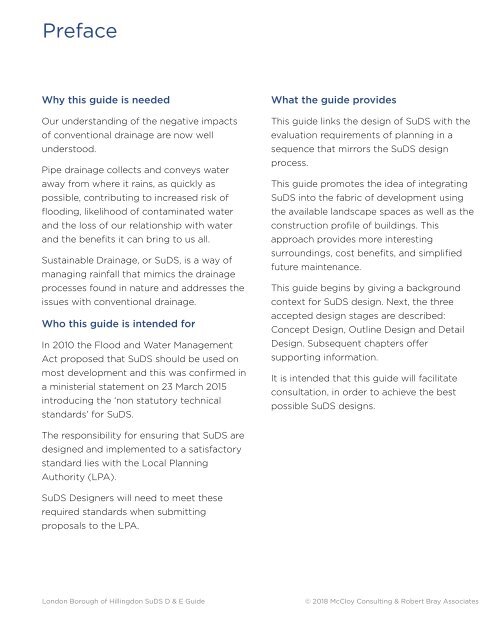Hillingdon SuDS Design & Evaluation Guide
Create successful ePaper yourself
Turn your PDF publications into a flip-book with our unique Google optimized e-Paper software.
Preface<br />
4<br />
Why this guide is needed<br />
Our understanding of the negative impacts<br />
of conventional drainage are now well<br />
understood.<br />
Pipe drainage collects and conveys water<br />
away from where it rains, as quickly as<br />
possible, contributing to increased risk of<br />
flooding, likelihood of contaminated water<br />
and the loss of our relationship with water<br />
and the benefits it can bring to us all.<br />
Sustainable Drainage, or <strong>SuDS</strong>, is a way of<br />
managing rainfall that mimics the drainage<br />
processes found in nature and addresses the<br />
issues with conventional drainage.<br />
Who this guide is intended for<br />
In 2010 the Flood and Water Management<br />
Act proposed that <strong>SuDS</strong> should be used on<br />
most development and this was confirmed in<br />
a ministerial statement on 23 March 2015<br />
introducing the ‘non statutory technical<br />
standards’ for <strong>SuDS</strong>.<br />
The responsibility for ensuring that <strong>SuDS</strong> are<br />
designed and implemented to a satisfactory<br />
standard lies with the Local Planning<br />
Authority (LPA).<br />
<strong>SuDS</strong> <strong>Design</strong>ers will need to meet these<br />
required standards when submitting<br />
proposals to the LPA.<br />
What the guide provides<br />
This guide links the design of <strong>SuDS</strong> with the<br />
evaluation requirements of planning in a<br />
sequence that mirrors the <strong>SuDS</strong> design<br />
process.<br />
This guide promotes the idea of integrating<br />
<strong>SuDS</strong> into the fabric of development using<br />
the available landscape spaces as well as the<br />
construction profile of buildings. This<br />
approach provides more interesting<br />
surroundings, cost benefits, and simplified<br />
future maintenance.<br />
This guide begins by giving a background<br />
context for <strong>SuDS</strong> design. Next, the three<br />
accepted design stages are described:<br />
Concept <strong>Design</strong>, Outline <strong>Design</strong> and Detail<br />
<strong>Design</strong>. Subsequent chapters offer<br />
supporting information.<br />
It is intended that this guide will facilitate<br />
consultation, in order to achieve the best<br />
possible <strong>SuDS</strong> designs.<br />
London Borough of <strong>Hillingdon</strong> <strong>SuDS</strong> D & E <strong>Guide</strong><br />
© 2018 McCloy Consulting & Robert Bray Associates


